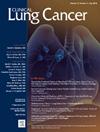Histologic Transformation of ALK-Rearranged Lung Adenocarcinomas to High-Grade LCNEC: Clinical and Molecular Description of Three Cases
IF 3.3
3区 医学
Q2 ONCOLOGY
引用次数: 0
Abstract
- •Anaplastic lymphoma kinase (ALK) rearrangements occur in 3-5% of non-small cell lung cancer (NSCLC) cases, with high sensitivity to ALK-tyrosine kinase inhibitors (TKIs) like alectinib, brigatinib, lorlatinib, and ensartinib. Resistance to tehse treatments is common and nearly inevitable, driven by genetic alterations and histologic transformations, notably to small cell lung carcinoma (SCLC).
- •In the present series, we describe a rare resistance mechanism in three cases of ALK-rearranged NSCLC transforming into high-grade large cell neuroendocrine carcinoma (LCNEC) after ALK-TKI treatment. These patients exhibited both histologic transformation and on-target ALK mutations, such as L1196M, D1203N, and L1198F, emphasizing the dual resistance mechanisms.
- •The identification of LCNEC transformation as a resistance mechanism emphasizes the importance of individualizing treatment strategies. The clinical outcomes of LCNEC-transformed cases varied, with some patients responding poorly to chemotherapy, underscoring the aggressive nature of this transformation. Regular tissue re-biopsies at disease progression can guide therapy choices by identifying resistance mechanisms. Liquid biopsies can serve as an alternative for monitoring molecular resistance in situations where tissue biopsies are not attainable. These findings advocate for an adaptive treatment approach, integrating molecular and histologic evaluations to optimize outcomes for patients with ALK-rearranged NSCLC.
alk重排肺腺癌向高级别LCNEC的组织学转化:3例临床和分子描述。
•间变性淋巴瘤激酶(ALK)重排发生在3-5%的非小细胞肺癌(NSCLC)病例中,对ALK-酪氨酸激酶抑制剂(TKIs)如alectinib、brigatinib、lorlatinib和恩沙替尼高度敏感。由于遗传改变和组织学转变,尤其是小细胞肺癌(SCLC),对这些治疗的耐药性是常见的,几乎是不可避免的。•在本系列中,我们描述了三例alk重排NSCLC在ALK-TKI治疗后转化为高级别大细胞神经内分泌癌(LCNEC)的罕见耐药机制。这些患者表现为组织学转化和靶向ALK突变,如L1196M、D1203N和L1198F,强调了双重耐药机制。•LCNEC转化为耐药机制的发现强调了个体化治疗策略的重要性。lcnec转化病例的临床结果各不相同,一些患者对化疗反应不佳,强调了这种转化的侵袭性。在疾病进展时,定期组织再活检可以通过确定耐药机制来指导治疗选择。在无法进行组织活检的情况下,液体活检可作为监测分子耐药性的替代方法。这些发现提倡适应性治疗方法,结合分子和组织学评估来优化alk重排NSCLC患者的预后。
本文章由计算机程序翻译,如有差异,请以英文原文为准。
求助全文
约1分钟内获得全文
求助全文
来源期刊

Clinical lung cancer
医学-肿瘤学
CiteScore
7.00
自引率
2.80%
发文量
159
审稿时长
24 days
期刊介绍:
Clinical Lung Cancer is a peer-reviewed bimonthly journal that publishes original articles describing various aspects of clinical and translational research of lung cancer. Clinical Lung Cancer is devoted to articles on detection, diagnosis, prevention, and treatment of lung cancer. The main emphasis is on recent scientific developments in all areas related to lung cancer. Specific areas of interest include clinical research and mechanistic approaches; drug sensitivity and resistance; gene and antisense therapy; pathology, markers, and prognostic indicators; chemoprevention strategies; multimodality therapy; and integration of various approaches.
 求助内容:
求助内容: 应助结果提醒方式:
应助结果提醒方式:


